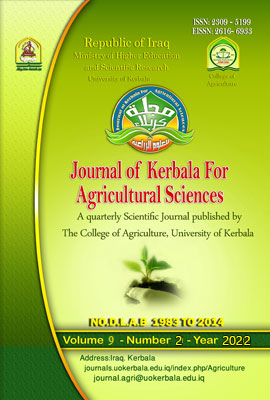Effect of gamma rays and sodium chloride on increasing the concentration of cardiac glycoside compounds of Digitalis lanata In vitro
DOI:
https://doi.org/10.59658/jkas.v9i2.967Keywords:
Cardiac glycosides, Digitalis, Gamma ray, NaCl, Plant tissue cultureAbstract
The Explants that was used in the experiment to stimulate the production of glycoside compounds is the tips of the vegetative branches with a length of 2 cm obtained from the stage of vegetative multiplication growing from seeds treated with gamma radiation with a dose of (0, 30) gray, the tips of the branches were planted on MS nutrient medium prepared with different concentrations Of NaCl (3,0, 6, 9, 12) g.l-1 to know the effect of irradiation, sucrose and maltose in stimulating the production of cardiac glycoside compounds, chlorophyll and carbohydrates, the data showed that the concentration of 12 g.l-1 was better in increasing the active compounds: Digoxin, Digitoxin, and Gitoxin (129.46, 171.70, 145.59) μg.g-1 dry weight, respectively, while the neutral treatment was superior in increasing the rate of chlorophyll, which amounted to 2.10 µg.g-1, while the concentration of 3 g.l-1 gave the highest rate of carbohydrates amounting to 2.94 µg.g-1, and the irradiation treatment was significantly superior in The increase in the production of glycoside compounds reached (127.95, 193.95, 161.31) µg.g-1 dry weight, respectively, and the rate of chlorophyll and carbohydrates reached (2.38 and 3.11) µg.g-1, respectively.
Downloads
Published
How to Cite
Issue
Section
License
Copyright (c) 2022 Copyright (c) 2024 is the Author's article. Published by the Journal of Kerbala for Agricultural Sciences under a CC BY 4.0 license

This work is licensed under a Creative Commons Attribution 4.0 International License.
Licensing Terms
All articles are published under a Creative Commons License and will be directed to the Creative Commons Attribution 4.0 International License (CC BY 4.0) That permits use, distribution, and reproduction in any medium, provided the original work is properly cited. This license also allows the work to be used for commercial purposes.
Use by both non-commercial and commercial users
This content is licensed under a Creative Commons Attribution 4.0 International (CC BY 4.0) license, permitting use by both non-commercial and commercial users. Individual users may access, download, copy, display, and redistribute the articles to colleagues, as well as adapt, translate, and text- and data-mine the content, subject to the following conditions:
- The author's moral rights, including the right of attribution and the right to protect their work from derogatory treatment, are respected.
- Where content in the article is identified as belonging to a third party, users must ensure that any reuse complies with the copyright policies of the owner of that content.
- If the article content is reused for research or educational purposes, users should maintain a link to the appropriate bibliographic citation, including the DOI and a link to the published version on the journal's website.

